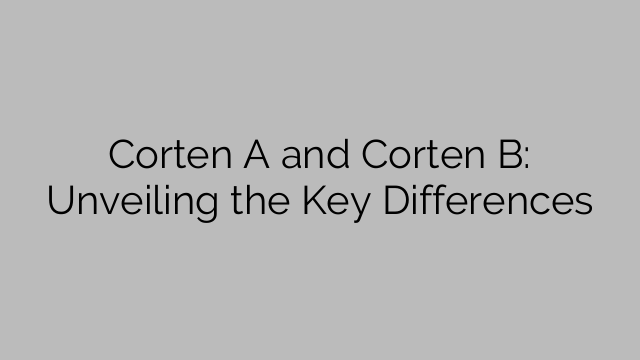Corten A and Corten B are both trademarks of United States Steel Corporation, who developed these weathering steel grades in the 1930s for use in railway coal wagons. They were termed “weathering” steels due to their ability to withstand corrosion and weathering effects caused by exposure to atmospheric conditions.
One of the main differences between Corten A and Corten B is their alloy composition. Corten A is primarily made up of iron, copper, chromium, and nickel, while Corten B includes iron, copper, chromium, nickel, and phosphorous. This difference in chemical composition leads to varying properties and performance characteristics.
Corten A is known for its higher yield strength and better mechanical properties compared to Corten B. It has a minimum tensile strength of 485 MPa and a minimum yield strength of 345 MPa, making it suitable for structural applications. Corten B, on the other hand, has a minimum tensile strength of 580 MPa and a minimum yield strength of 345 MPa, making it more suitable for aesthetic purposes, such as sculptures or architectural components.
Another key difference between the two weathering steel grades is their resistance to atmospheric corrosion. Corten A and Corten B both form a protective rust-like appearance when exposed to the elements, but Corten B has higher resistance to corrosion due to the additional phosphorous element in its composition. This enhanced resistance makes Corten B more suitable for applications in highly corrosive environments, such as coastal areas or industrial settings.
When it comes to applications, Corten A and Corten B are both used in a variety of outdoor structures and architectural designs. Corten A is commonly used in bridges, railway wagons, facades, and structural applications, where its higher strength and mechanical properties are required. On the other hand, Corten B is often used in decorative elements, sculptures, and architectural components, where its enhanced resistance to corrosion and aesthetic appearance are valued.
Both Corten A and Corten B offer several benefits that make them popular choices in outdoor applications. Firstly, their unique rust-like appearance adds a distinctive and natural appeal to structures, making them stand out in any environment. Secondly, their self-repairing properties help to prolong the lifespan of the material and reduce the need for maintenance and costly repairs. Lastly, their high strength and durability make them suitable for withstanding harsh weather conditions and heavy loads.
In conclusion, while Corten A and Corten B are both weathering steel grades designed to resist corrosion and weathering effects, they have key differences in terms of alloy composition, mechanical properties, and resistance to corrosion. Understanding these differences is crucial when selecting the appropriate weathering steel grade for specific applications. Whether it is for structural purposes or aesthetic designs, both Corten A and Corten B offer unique benefits that contribute to their widespread use in various outdoor projects.
[ad_2]

